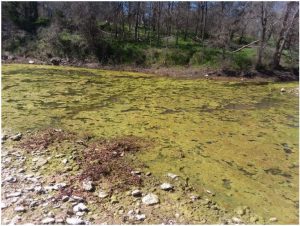SEWAGE THREATENS BARTON CREEK
New Research Links Long Branch Wastewater Permit as a Threat to Barton Creek
AUSTIN— The City of Austin released a study implicating a new wastewater permit application as a potential pollution source that would damage Barton Creek. Sawyer-Cleveland Partnership, LLC, seeks approval to pipe up to 92,000 gallons per day of treated sewage into Long Branch, a tributary of Barton Creek. The location of the proposed plant is near the intersection of U.S Hwy 290 and Sawyer Ranch Road.
Sawyer-Cleveland Partnership has no immediate plans for what might be served by the treatment plant but cite future commercial and residential development. Their plan involves wastewater flowing through several ponds in a residential subdivision called Polo Club, then being released into Barton Creek. The ponds are used both for detention and as an aesthetic amenity.
Current clarity of Barton Creek at Shield Ranch
The City of Austin, community organizations, landowners and residents have expressed concerns about the plan. Shield Ranch, a family ranch on Barton Creek, is a protected wildland with conservation easements held by the City of Austin and the Nature Conservancy to conserve water quality and wildlife habitat. Long Branch joins Barton Creek on Shield Ranch. Bob Ayres, president and CEO and one of the owners, said his family is opposed to the proposed permit. “Our family has taken great care to protect this land and Barton Creek for the benefit of future generations. We are opposed to direct discharge of wastewater into Hill Country creeks because it alters the natural hydrologic regime and risks the degradation of water quality in Barton Creek.”
The City of Austin used a water quality model to understand how the discharge would affect the creek. The model’s results show the creek will experience algae blooms due to excess nutrients in the water - resulting in low-oxygen levels that kill aquatic species and harm their habitats.
“The model shows that the extra nutrients that will enter Barton Creek from the discharge, will degrade the water quality of Barton Creek and the aquifer,” said Chris Herrington, City of Austin Environmental Officer. Algae would change the appearance of the creek and impair recreational activities such as swimming.

Algae in a Hill Country Stream
Mark Gentle, President of Barton Hills Neighborhood Association stated, “Our neighborhood is very concerned about this proposal. We plan to monitor this closely.”
The treatment plant needs approval from the Texas Commission on Environmental Quality (TCEQ), the state regulating agency. “Direct discharge”,i.e., dumping treated sewage in creeks and rivers, is not allowed in the Barton Springs Edwards Aquifer recharge zone. However, the location of this proposed plant is in the “contributing zone,” which means that water that originates here also gets into the aquifer.
“Unfortunately, while this practice is illegal in the recharge zone, the loophole allowing treated wastewater to be discharged in the contributing zone puts the Barton Creek and the aquifer at risk.” says Angela Richter, Executive Director of Save Barton Creek Association.
To understand the potential negative impacts of wastewater effluent in waterways, critics point to the South San Gabriel River which has been plagued by contamination from the Liberty Hill wastewater treatment plant for over a year.
Across Central Texas, concerns abound about the impacts of wastewater plant discharges into waterways. A campaign called “No Dumping Sewage” spearheaded by Save Barton Creek Association, Wimberley Valley Watershed Association, Greater Edwards Aquifer Alliance, and Clean Water Action against wastewater pollution can be found at www.nodumpingsewage.org. Their petition has over 3,900 individuals and 10 organizations that have signed a petition stating “We support a ban on dumping treated sewage into creeks and rivers above the Edwards Aquifer, in favor of safer alternatives.”
A natural refuge close to downtown, Barton Creek helps recharge the aquifer that feeds Barton Springs pool and serves as a hotspot for tourists and residents alike to enjoy the beauty of Austin. From hiking the 8-mile greenbelt to swimming at Twin Falls, Barton Creek provides numerous activities for people to explore.
“We are very concerned about the impact of this proposal on the habitat in Barton Creek and also the aesthetics and safety of recreational use of Barton Creek,” said Angela Richter, of Save Barton Creek Association, “Generations of Austinites have fought to keep Barton Creek clean and protected. We encourage those that are concerned to join us in writing to TCEQ and signing the No Dumping Sewage petition.”
For additional information, please see:
City of Austin, Modeling Paper on Proposed Long Branch Wastewater Treatment Plant Discharge Impacts to Barton Creek: http://www.austintexas.gov/watershed_protection/publications/document.cfm?id=319580
City of Austin, Modeling Paper on Proposed Long Branch Wastewater Treatment Plant Discharge Impacts to the Ponds in the Polo Club Subdivision:
http://www.austintexas.gov/watershed_protection/publications/document.cfm?id=319579
Story by Save Barton Creek Association
Contact: [email protected]
